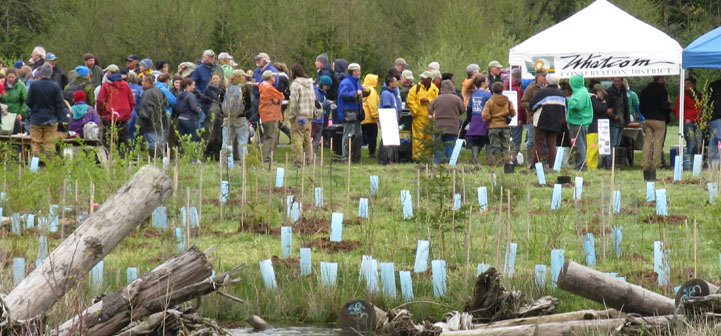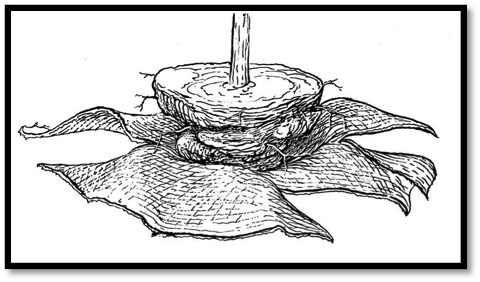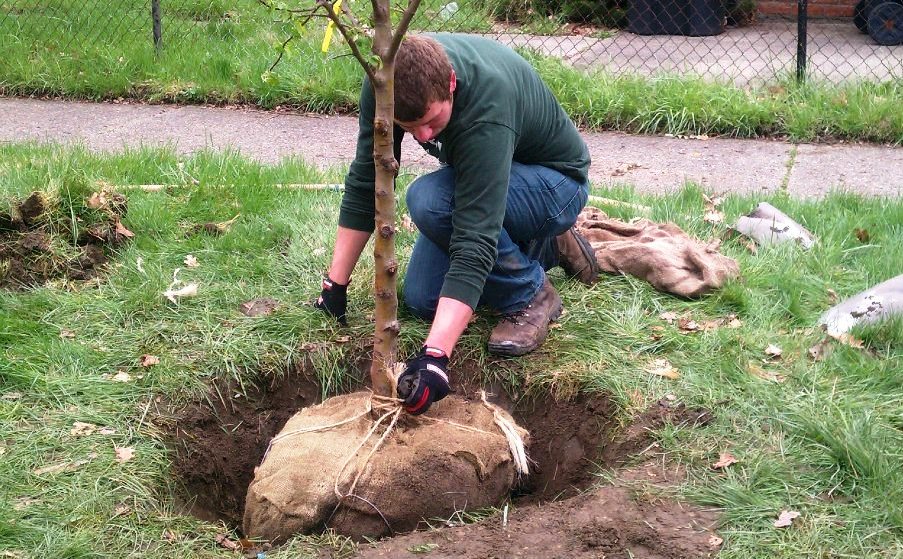
Millionth Tree Planting Celebration, Whatcom Conservation District.
After selecting a good site to plant an urban tree and then preparing the site for planting, the next step is tree selection and planting.
Tree Selection
Selecting healthy tree stock is critical. Trees should be purchased from a reputable source. Once the trees have been delivered to the site, keep them watered and protected from extreme weather conditions.The stock may need time to adapt if the conditions at the site are much different from the previous growing conditions. The following considerations should be made when selecting nursery trees:
Species Selection There are several factors to consider when selecting an urban tree that will prevent future problems and achieve planting objectives, including a tree’s:
- Growth habit & size
- Form
- Growth rate
- Wood strength
- Rooting depth
- Pest resistance
- Longevity
- Leaf type
- Thorns, flowers, fruits
- Native vs. exotic
Nursery-Grown Trees Nurseries grow trees in a variety of ways, from plastic pots and cloth containers to field-grown trees (bare root or balled and burlap). Often times, field-grown trees are “root pruned” to encourage increased root growth. The practice can improve tree survival and growth. With sufficient irrigation after planting, all types of nursery-grown trees will have excellent to good survival after planting, however only balled and burlap or bare root seedlings/ saplings have good survival after planting with insufficient irrigation (Gilman and Partin, University of Florida, IFAS). Trees of 2 inch caliper (diameter of trunk six inches above soil) or less are recommended unless a larger size is justified. Smaller trees recover from transplant shock and commence with normal growth more quickly than larger trees.
Inspection The tree should have been inspected at the nursery to insure it meets the minimum standards for the American Standard for Nursery Stock. It should be inspected again at the site for damage from handling, transportation, or storage, with particular attention to the roots. Healthy nursery trees will have the following:
- No girdling, kinked, or circling roots (some of these root issues can be corrected at planting by spreading out the roots in the planting hole or removing girdling or kinked roots, but nursery trees with severe cases of any of these should be avoided).
- One main trunk, or dominant leader-for a high quality shade tree.
- No evidence of trunk injury by pests, disease, or management activities
- A uniform and full canopy
- Good pruning scars
Handling A tree should be picked up from the bottom of the container, root ball, or root-ball cage. Never lift a tree by the trunk. This causes the trunk of the tree to pull away from the roots. Dropping the tree may also damage the roots. Carefully transport the tree from the nursery to avoid damage to the branches, leaves, needles, bark, and roots.
Storage Trees for transplanting usually should not be stored, particularly during the summer or winter, because the roots can dry out and die. Keep the roots moist, but not soaked. If trees, particularly bare-root trees, must be stored, “heel them in” by temporarily planting them and covering the roots with moist compost or sawdust. If they cannot be “heeled in,” they should be kept in a cool place, away from asphalt or concrete. If trees are warmed up too quickly, they will break dormancy before planting.
Tree Planting Guidelines
Certain steps should be followed when planting to help insure the successful establishment of the tree. One of the most important goals is to provide an environment that encourages root growth. Choosing a Planting Season: In many parts of the United States, late November to March is the best time to plant trees because temperatures are moderate, transpiration is minimal and water can go primarily to support healthy root growth. Fall planting is usually recommended, because it allows time for root growth before hot weather in the summer. In some areas of the South, winter planting is also an option. Weather conditions to avoid include extreme heat and cold, low wind-chill temperatures, and high winds that may cause drought conditions.
When planting, consider the following:
- Soil moisture — Good planting conditions require the soil to be moist. If the soil is too wet or too dry, avoid planting.
- Soil texture — Digging in clay soil may be more difficult and require more time for planting.
- Soil compaction — If the soil is hard to penetrate, a rototiller, hoedad, maddock, or pick can be used to loosen the soil.
- Soil temperature — The soil needs to be warm enough, usually above 40 degrees F, for root growth. Avoid planting if the soil is frozen.
- Soil interfaces — Watch for rocks and construction debris when loosening the soil with tools and mechanical equipment.
- Soil amendments — Do not add organic matter, fertilizer, or other soil amendments. Also, do not place gravel in the bottom of the planting area. These amendments can cause problems with soil moisture and root growth.
Digging the Hole The planting hole should be at least twice the width of the rootball or container to encourage the roots to grow into the surrounding soil with the sides of the planting hole sloped with the larger width at the top. Most trees have the root flare below the top of the ball or soil in the container, so digging a hole the same depth of the ball or soil in the container often results in planting the tree too deep. The depth of the hole should be the same as the distance from the root flare of the tree to the bottom of the container or ball. One can check the root flare depth by probing down next to the trunk to look and find the flare.
Tree Preparations Containers (plastic pots) and wrappings should always be removed from the rootball just before planting to prevent soil from drying out. Do not disturb the rootball or injure the roots when the container or wrapping is removed. Any dead, diseased, broken, twisted, or girdling roots should be cut with a sharp knife. Circling roots need to be cut in a few places to help keep them from becoming girdling roots. Girdling roots need to be cut back to where the root is growing away from the rootball. If there are matted roots, make two or three vertical slices into the rootball with a sharp knife, or loosen the roots carefully with your hands. Remove all wrapping cords, especially nylon string or rope once the tree is in position. (A planting hole does not have to be round.)
- For container trees, remove the container. Place the root “ball” in the hole. Cut the circling roots in the outer part of the ball with 4 to 6 cuts, or gently pull the roots out of the ball and plant them in trenches leading away from the planting hole.
- For B&B (burlap/wire basket) trees, place the ball in the hole, then remove the rope around the trunk, and then reach down in the hole and cut away as much burlap as possible.
- For a basket, use wire cutters to remove as much of the wire basket as possible, at least the top 2/3 of the root ball,. This should be done after the tree is in its final position and ready to be back filled.

All tags and labels need to be removed from the tree to prevent girdling of branches and trunk. Carefully place the bare roots or root ball in the planting area. In most cases, the root crown, where the roots end and the trunk begins, needs to be slightly above ground level. Straighten or prune the roots of bare-root trees to prevent circling, girdling, or crossing roots.
 |
| Photo credit: The Greening of Detroit. |
Backfill Use the same soil that was taken out of the hole. If the soil is very poor and appears to need topsoil, increase the hole size and sparingly mix in some local topsoil (avoid using potting soil, peat moss, and soil amendments). Remove stones and other debris. Fill the hole halfway with backfill, then water. Finish filling the hole with the backfill and water again. Make sure to work the soil around the ball firmly to eliminate any air pockets, but avoid packing the soil too hard since this can reduce soil pores and cause compaction.. Also, make sure the tree is vertical and properly supported, but do not pack the soil around the trunk.
Mulch The area around the tree should be mulched with wood chips, bark chips, or pine mulch. The mulch should be 3 to 4 inches thick and cover the entire planting area and the edges beyond the fill. The mulch needs to be placed in a donut or tire shape around the trunk of the tree. The mulch must be kept away from the trunk of the tree to keep insects away and prevent the trunk from being excessively wet. Mulch helps conserve soil moisture, reduces the competition from unwanted weeds, keeps lawn mowers and string trimmers from damaging the trunk, and moderates soil temperature extremes. Do not use sawdust, black plastic, or grass clippings as mulch. Do not make mulch volcanos up the trunk of the tree.
Trunk Wrap Research indicates there are no benefits from using trunk wraps. Wrapping may encourage damaging insects or diseases on the trunk.
Staking Staking is not necessary if the tree has a proper size rootball and has not been pruned too high. Stakes may, however, help prevent lawnmowers and string trimmers from damaging the tree. If staking is needed for support, attach them so the tree has some sway. NEVER leave wires or straps on the tree for more than one growing season.
Fertilizing Generally new trees do not need fertilizers. Using the wrong product could damage the already reduced root system. Fertilize the first year only if a specific problem develops.
Pruning Prune only the branches that are dead, broken or severely deformed during the first growing season. Buds produce hormones that stimulate root growth, so keep the removal of buds to a minimum.
See other parts of this 3-part Tree Planting Series:
Above material adapted from Tree Planting Guidelines from the Tennessee Division of Forestry, Urban Forestry Program by Sarah Workman, UGA Warnell School of Forestry and Natural Resources.
You can see other guidelines and additional information in the articles Guidelines for Planting an Urban Tree and Urban Tree Planting Guidelines.
For related information also see
Preparing the Planting Stock for Urban Tree Plantings, Preparing Tree Planting Holes-eXtension, Tree Planting Guidelines, and Urban Tree Planting Guidelines.
To learn this content and more for volunteer credit and a certificate of completion, go to campus.extension.org and enroll in eLearn Urban Forestry.
By: Ed Macie, Regional Urban Forester, USFS Southern Region; Sarah Workman, University of Georgia; Larry Morris, Professor-Forest Soils, University of Georgia; Holly Campbell, Southern Regional Extension Forestry
